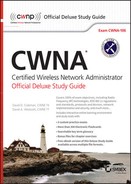Book Description
Complete CWNA-106 prep, with full coverage and hands-on practice
CWNA Certified Wireless Network Administrator Deluxe Study Guide is your official study guide for the leading wireless certification program. Updated for the new CWNA-106 exam, this book provides coverage of all exam objectives, plus review questions and hands-on exercises that help you build your skills and your confidence before exam day. Start with a pre-assessment test to find out how much you already know, then fill in the gaps with detailed coverage of radio frequency technology, regulations and standards, protocols and devices, network implementation and security, RF site surveying, and much more. Sybex's interactive online learning environment and test bank gives you access to hundreds of questions and robust study tools, including chapter tests, practice exams, flashcards, a glossary of key terms, and bonus chapter material — all to help you prepare for and increase your chances of passing the exam the first time around.
Find your starting point with a pre-assessment test
Get up to speed on all CWNA-106 exam objectives
Sharpen your practical skills with hands-on exercises
Test your knowledge with practice exam questions
Savvy candidates know that strategic prep is essential to first-time success, and CWNA Certified Wireless Network Administrator Deluxe Study Guide is your toolbox for building the next step in your wireless career.
Table of Contents
- Cover Page
- Title Page
- Copyright
- Acknowledgments
- About the Authors
- Contents at a Glance
- Contents
- Foreword
- Introduction
- About CWNA ® and CWNP ®
- How to Become a CWNA
- Who Should Buy This Book?
- Interactive Online Learning Environment and Test Bank
- How to Use This Book and Test Bank
- CWNA Exam (CWNA-106) Objectives
- Radio Frequency (RF) Technologies
- IEEE 802.11 Regulations and Standards
- IEEE 802.11 Protocols and Devices
- IEEE 802.11 Network Implementation
- IEEE 802.11 Network Security
- IEEE 802.11 RF Site Surveying
- Assessment Test
- Chapter 1: Overview of Wireless Standards, Organizations, and Fundamentals
- Chapter 2: Radio Frequency Fundamentals
- Chapter 3: Radio Frequency Components, Measurements, and Mathematics
- Chapter 4: Radio Frequency Signal and Antenna Concepts
- Azimuth and Elevation Charts (Antenna Radiation Envelopes)
- Interpreting Polar Charts
- Beamwidth
- Antenna Types
- Visual Line of Sight
- RF Line of Sight
- Fresnel Zone
- Earth Bulge
- Antenna Polarization
- Antenna Diversity
- Multiple-Input, Multiple-Output
- Antenna Connection and Installation
- Antenna Accessories
- Regulatory Compliance
- Summary
- Exam Essentials
- Review Questions
- Chapter 5: IEEE 802.11 Standards
- Chapter 6: Wireless Networks and Spread Spectrum Technologies
- Industrial, Scientific, and Medical Bands
- Unlicensed National Information Infrastructure Bands
- 3.6 GHz Band
- 4.9 GHz Band
- Future Wi-Fi Frequencies
- Narrowband and Spread Spectrum
- Frequency Hopping Spread Spectrum
- Direct Sequence Spread Spectrum
- Packet Binary Convolutional Code
- Orthogonal Frequency Division Multiplexing
- 2.4 GHz Channels
- 5 GHz Channels
- Adjacent, Nonadjacent, and Overlapping Channels
- Throughput vs. Bandwidth
- Communication Resilience
- Summary
- Exam Essentials
- Review Questions
- Chapter 7: Wireless LAN Topologies
- Chapter 8: 802.11 Medium Access
- Chapter 9: 802.11 MAC Architecture
- Chapter 10: WLAN Architecture
- Chapter 11: WLAN Deployment and Vertical Markets
- Deployment Considerations for Commonly Supported WLAN Applications and Devices
- Corporate Data Access and End-User Mobility
- Network Extension to Remote Areas
- Bridging: Building-to-Building Connectivity
- Wireless ISP: Last-Mile Data Delivery
- Small Office/Home Office
- Mobile Office Networking
- Branch Offices
- Educational/Classroom Use
- Industrial: Warehousing and Manufacturing
- Retail
- Healthcare: Hospitals and Offices
- Municipal Networks
- Hotspots: Public Network Access
- Stadium Networks
- Transportation Networks
- Law Enforcement Networks
- First-Responder Networks
- Fixed Mobile Convergence
- WLAN and Health
- WLAN Vendors
- Summary
- Exam Essentials
- Review Questions
- Chapter 12: WLAN Troubleshooting and Design
- Chapter 13: 802.11 Network Security Architecture
- Chapter 14: Wireless Attacks, Intrusion Monitoring, and Policy
- Chapter 15: Radio Frequency Site Survey Fundamentals
- Chapter 16: Site Survey Systems and Devices
- Chapter 17: Power over Ethernet (PoE)
- Chapter 18: 802.11n
- Chapter 19: Very High Throughput (VHT) and 802.11ac
- 802.11ac-2013 Amendment
- 5 GHz Only
- 20, 40, 80, and 160 MHz Channels
- 256-QAM Modulation
- Modulation and Coding Schemes
- Single-User MIMO
- 802.11ac Data Rates
- VHT MAC
- Beamforming
- Quality of Service
- Infrastructure Requirements
- 802.11ac in a SOHO or Home
- Wi-Fi Alliance Certification
- Summary
- Exam Essentials
- Review Questions
- Chapter 20: Bring Your Own Device (BYOD)
- Appendix A: Answers to Review Questions
- Chapter 1: Overview of Wireless Standards, Organizations, and Fundamentals
- Chapter 2: Radio Frequency Fundamentals
- Chapter 3: Radio Frequency Components, Measurements, and Mathematics
- Chapter 4: Radio Frequency Signal and Antenna Concepts
- Chapter 5: IEEE 802.11 Standards
- Chapter 6: Wireless Networks and Spread Spectrum Technologies
- Chapter 7: Wireless LAN Topologies
- Chapter 8: 802.11 Medium Access
- Chapter 9: 802.11 MAC Architecture
- Chapter 10: WLAN Architecture
- Chapter 11: WLAN Deployment and Vertical Markets
- Chapter 12: WLAN Troubleshooting and Design
- Chapter 13: 802.11 Network Security Architecture
- Chapter 14: Wireless Attacks, Intrusion Monitoring, and Policy
- Chapter 15: Radio Frequency Site Survey Fundamentals
- Chapter 16: Site Survey Systems and Devices
- Chapter 17: Power over Ethernet (PoE)
- Chapter 18: 802.11n
- Chapter 19: Very High Throughput (VHT) and 802.11ac
- Chapter 20: Bring Your Own Device (BYOD)
- Appendix B: Abbreviations and Acronyms
- Index
